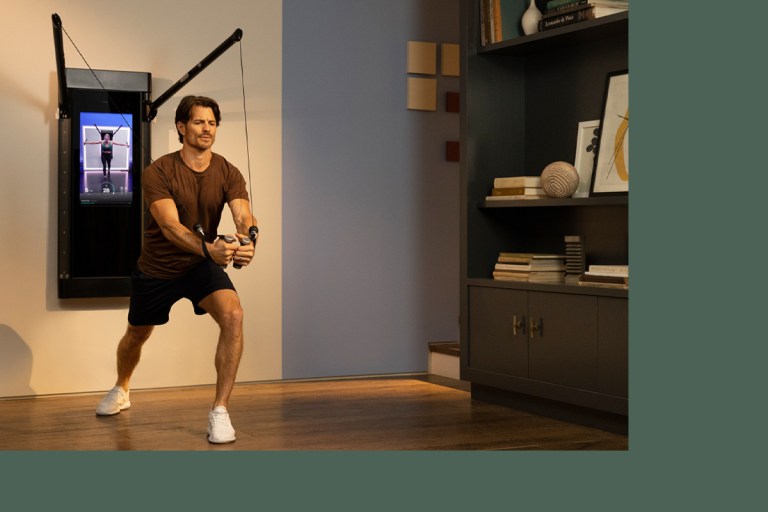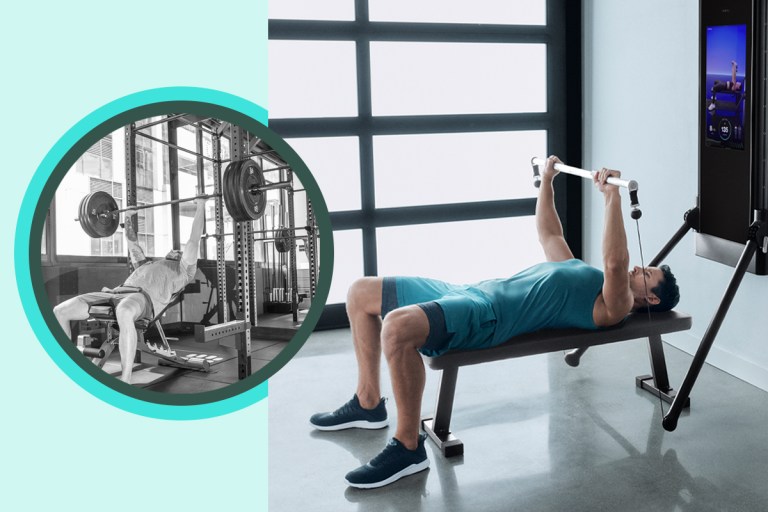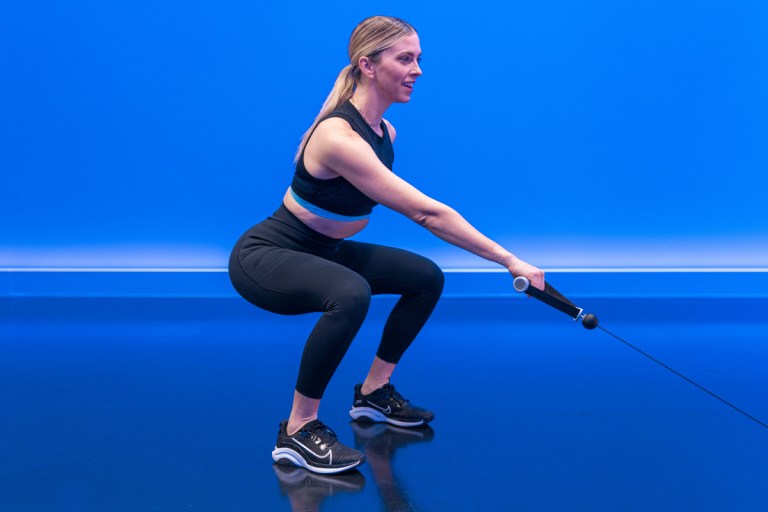Pickleball Power: How Strength Training Can Improve Your Game
Gain power and speed on the court and injury-proof your body with resistance training and mobility work.

Like many people, Tonal coach and personal trainer Ackeem Emmons hadn’t even heard of pickleball until last year when a group of friends roped him into joining them on the court.
“It sounded ridiculous, but once I went, I had the best time,” he says. “I was so bad at the beginning, but it was so much fun.” Now, he says he’s “addicted” to the game.
Emmons isn’t the only one. Pickleball is booming with an estimated 36.5 million players as of January 2023, up from 5 million two years earlier, making it the fastest-growing sport in America. It’s easy to understand why: With a smaller court and lighter-weight equipment than tennis, pickleball is a more approachable sport and, since it’s usually played as doubles, includes a social element.
That’s not to say pickleball doesn’t require athleticism. As you dart around the court attempting to defeat your opponents in fast-paced rallies, you’ll quickly feel your heart rate increasing and your muscles burning. “When people start to play, they realize how much of a full-body workout it is,” says Tonal coach and personal trainer Kristina Centenari, who grew up playing tennis competitively and has also dabbled in pickleball.
Both Centenari and Emmons suggest incorporating strength training to prep for the physical demands of pickleball. By training your major muscle groups and incorporating plyometrics for speed and conditioning, you’ll build your power, agility, and resilience—boosting your performance and confidence on the court.
Even if you’re just playing pickleball for fun, adding strength training and mobility to your routine is pivotal in preventing common injuries. As the game grows in popularity, pickleball injuries are also on the rise, according to a 2021 study. The most common complaints are sprains and strains. While 85 percent of injuries were reported in players 60 and older, strengthening your muscles, tendons, and joints through resistance training has been shown in multiple studies to reduce the risk of sports injuries for adults of all ages.
Pickleball coach Shea Underwood relies on Tonal for his supplemental strength training. “Tonal has made strength training completely frictionless. I’m constantly looking for ways to improve my pickleball game and this has been one of the best,” he says. “It’s fun, it’s refreshing, and it feels so good to see the results both on and off the court.”
This summer, Tonal is launching a four-part series of workouts designed specifically for pickleball, starting with Pickleball Power: Strength Gains and Pickleball Power: Positioned to Win.
Here are the moves Centenari, Emmons, and Underwood recommend if you want to improve your pickleball game and keep playing injury-free:
Rotational Chop

Why it Works: Centenari is a big fan of rotational exercises that involve transferring power from the lower to the upper body and pivoting on your feet—two actions you’ll need for a strong swing. “If you start with loaded rotational movements, then you can transfer that [motion] over to the court and add some velocity to it,” she says. “When you’re just holding the paddle, it’s going to feel lighter than your rotational chop on Tonal, so [you’ll be able to] move faster through the swing.” Emmons agrees that this move can improve both your forehand and backhand swings.
How to Do it: With your inside leg, press the floor away from you and rotate the pelvis to shift your body weight onto the outside leg. Rotate at the torso and bring the rope across your body and down toward your inside hip like you’re buckling a seatbelt. Bring the rope back to start, sit into the inside hip and repeat.
Barbell Front Squat

Why it Works: For building lower-body power, Centenari says you can’t beat the classic squat. Along with being a foundational exercise for developing leg strength, Underwood says the barbell front squat has helped him in changing up his grip to protect his shoulders at the line.
How to Do it: Place the barbell on top of the shoulders until it is just barely touching the front of the neck. Cross your arms and lift the elbows to keep the bar in place. Stand with feet shoulder-width apart, toes slightly turned out. Reach the hips back and down like you’re into a chair behind you. Press the floor away from you by squeezing your glutes, powering your hips toward Tonal, and standing tall.
Single-Arm Rotational Punch

Why it Works: Another rotational movement, the single-arm rotational punch is one of Underwood’s favorites. “I’ve been develping a two-handed backhand and this is perfect for helping me gain more power,” he says. “I’ve noticed a significant difference in my put-away power [the ability to hit an unreturnable shot] and paddle speed since training this movement.”
How to Do it: Stand facing away from Tonal in a wide stance and knees soft. Take a handle in one hand and bring it to your chest with your elbow bent and your resting arm in the same position. Rotate at your torso and push across your body, keeping your arm parallel to the floor, while the resting arm swings up and back toward Tonal. Rotate back to face forward as you bring the arms back to the starting position and repeat.
Resisted Lateral Lunge
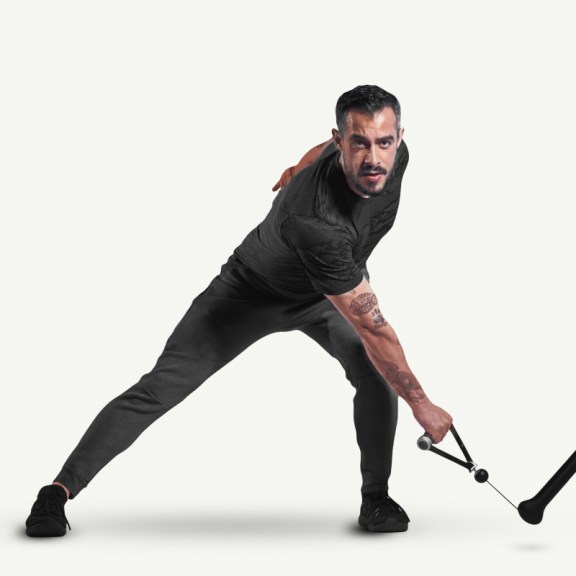
Why it Works: In addition to compound lifts, Centenari says you’ll also want to include single-leg moves to strengthen and stabilize the ankle and foot complex. The resisted lateral lunge mirrors how you lunge and pivot on the course, and prepping your body to handle that movement can help with power and injury prevention. Plus, it’ll have you feeling the burn in your lateral glute muscles.
How to Do it: Take the handle in one hand and take a few large steps away from Tonal. Stand sideways so the handle is on the far side of your body with the cable crossing in front of you. Take a wide step toward Tonal and sit back into your inside leg like you’re sitting in a chair while keeping the other leg straight. Press the floor away from you with the inside leg and return to standing. Repeat on the same side.
Resisted Deep Lunge

Why it Works: When you’re chasing the ball on the pickleball court, you’ll be doing a lot of quick starting and stopping, often landing in position with your knees tracking over your toes. Centenari likes this move that trains the knees and ankles to handle that stimulus. “We see a lot of injuries just because the joint isn’t used to that load,” she says, “so you want to train your joints to handle this stress.”
How to Do it: Take the handle in one hand and bring the opposite leg forward about a foot behind Tonal’s arm. Reach the opposite leg back long and anchor the ball of the foot on the floor. With feet hip-distance apart, lower down by driving the front knee forward over your toes, while keeping the back leg straight and strong. Think escalator not elevator as you lower down. Pressing through the heel of the front foot, power back up to stand and repeat on the same side.
Resisted Step Up

Why it Works: This advanced unilateral move will challenge your balance along with your strength and help with the side-to-side movements of pickleball. “It involves really focusing on getting your hip, your knee, and your foot to work together,” says Centenari. If this exercise feels too challenging, start with a bodyweight step-up.
How to Do it: Take a handle in each hand. Place one foot on the center of your bench in line with the end of Tonal’s arms. Press through the heel like you’re squishing a bug to push the bench away from you and stand tall, keeping the resting leg relaxed. Lower down with control using your glute, lightly tap the floor with the relaxed leg and repeat on the same side.
Bent Over Row

Why it Works: Pickleball paddles are lighter than tennis rackets, but you can’t neglect upper-body strength. Because swinging the paddle involves a forward, pushing movement in the shoulder, Centenari recommends adding in upper-body pulling exercises, such as rows, to counteract all that swinging.
How to Do it: Grab the handles and take a small step back. Position yourself in an athletic stance facing Tonal with feet hip-width apart. Hinge at the hips into a bent-over position. Start with your palms facing the floor and pull the handles toward your ribcage using your back, rotating the palms to face each other. Aim your elbows to where the ceiling meets the wall as you pull. Keep control of the weight using your back as you lower the handles and repeat.
Skater Bound

Why it Works: Pickleball is played on a smaller court than tennis, but that doesn’t mean you won’t be running around during a game. According to Centenari, you might actually be doing more side-to-side movements in pickleball because it’s harder to predict the direction of the plastic ball’s bounce. “When you’re on a tennis court, the ball lands and it’s usually a true bounce. You know where it’s going to land and you can anticipate it. But with pickleball, the ball can land and it can go somewhere else,” she says, explaining why you’ll want to focus on your footwork.
Skater bounds are ideal training for all this start-and-stop, side-to-side pivoting. You’ll practice jumping laterally with force and also get your cardiovascular system involved as you pick up the pace. “Pickleball is high-intensity, and there is a little bit of impact, so these movements are going to definitely help out with agility,” says Emmons.
How to Do it: Bound up and to the side off of one foot and land on the other foot as soft as a ninja, by shifting your weight back and down gently. Once you land, bound back to the other leg.
90-90 Hip Stretch
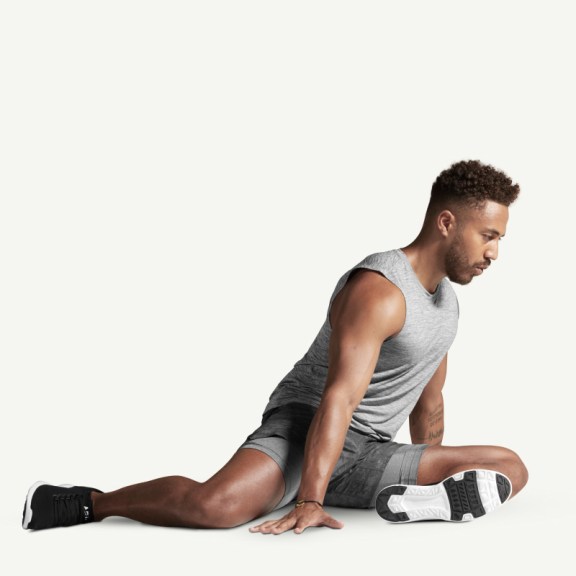
Why it Works: Since pickleball involves a lot of lateral movement, Centenari recommends this stretch for opening up your hips and preventing tendon and joint injuries. “Mobility is going to be huge,” she says, especially when it comes to avoiding common ankle, knee, and hip injuries caused by moving laterally.
How to Do it: Take a seat on your mat and create 90-degree angles with your front and back knees and hips. Bring your hands to the floor on each side of the front thigh. With a straight back, lean forward slightly opening your chest to your thigh to stretch the glute of the front leg. Slowly rise back up and repeat.
Reach and Rotate Opener

Why it Works: To relieve sore shoulder and upper-back muscles after a day of serving and volleying, Emmons likes this stretch that helps mobilize the upper thoracic spine and shoulders.
How to Do it: Get into a tall kneeling position on your mat and then sit back on your heels. Bring one hand out in front of you on the floor and the other just behind your ear, bending at the elbow. Rotate at the torso like you’re wringing out a towel, opening your body to the same side as your raised arm. Come back to face the floor and repeat on the same side.
